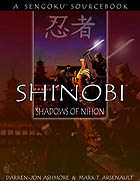
|
About OgreCave and its staff
|

|
by Darren MacLennan
Shinobi: Shadows of Nihon is about as close as anybody's ever going to get to truly historical ninjas. The people who write Sengoku are deadly serious about their historical research. This book is about the real ninja, the human beings who actually tried to live up to the fearsome reputation that they got - and the book takes incredible pains to make sure that the details of the book are as close to history as they can get, with the occasional diversion into some of the more fantastic elements of the ninja myth for GMs who are interested in more cinematic campaigns. They picked an incredibly difficult task and wound up doing it pretty darn well. Ninja have always had a rather iffy existence within a lot of role-playing games - mostly because they've been extraordinarily popular in American culture for the last thirty years or so. Most of that, in turn, is thanks to a wide variety of B-movies starring ninjas - the American Ninja movies spring to mind, for example. As a result, there's a lot of cultural white noise surrounding ninjas, reaching its climax in the campy, good-natured American Ninja movies. Shinobi goes for the strictly historical approach, where the ninja are very skilled, but not terrifically supernatural - unless, of course, you decide to let them have access to the Ki powers, or to ninja magic, in which case the game takes a turn towards the supernatural. One of the neat paradoxes of the book is that it's based on historical records which are themselves fairly biased - the ninja were apparently subjects of wild exaggeration back when they were still around. Instead of a single origin story, the book gives us four, ranging from the idea that ninja were descendents of supernatural creatures to the idea that they were the remnants of a powerful samurai clan laid low. The history ranges from their origins, to their development and heyday, to their interactions with the Europeans (sneaking aboard a European ship to steal valuable documents, only to wind up with a transcription of a sea shanty) to their eventual disbandment in 1866. I can't attest to the historical validity of the material, but it has the feel of material that's been intensely researched. This includes material on the ninja religion and/or code of honor, ranging from their reflection of the samurai to their take on Buddhism - fascinatingly enough, the book describes the ninja as regarding everything around them as their tools and friends - a universal animism. I'm not entirely sure why the book felt it necessary to describe the ninja's perspectives on the various classes of feudal Japan, especially since it radiates contempt for most of them - it's a page and a half, but its inclusion feels a little weird. More interesting is the stuff involving the ninja families - while I'm pretty sure that player samurai could, hypothetically, come from the same clan, the ninja draw their members entirely from the same family - with, say, the grandfather as the head of the clan and the children as the up-and-comers. I keep thinking about a campaign composed entirely of ninja within the same clan - sibling rivalries, old fights between relatives flaring up at the worst time, all manner of good stuff. It would require mature role-players, of course, but it's be a step beyond the usual we-just-happen-to-work-together motive of many adventuring parties. The book splits the ninja special abilities into two or three groups - or, more specifically, into realistic and non-realistic uses. There's a lot of new skills here which are specifically tuned for ninja, including vertical wall climbing (done by finding and exploiting miniscule holes in the wall), chemistry, astronomy, demolitions, the use of fire, nets, hypnotism, throwing shuriken and remaining perfectly still. A skilled ninja could climb up a sheer wall, sneak into the bedroom of a geisha, hypnotize her into throwing the fire grenade that he's going to leave somewhere else, and sneak back out again - again, it's all dependent on how cinematic you want the game to be. The Ki powers obviously shade much more towards the fantastic end of the pool, including the very anime-esque "twenty thousand cherry blossoms" technique - where you surround yourself with a swirling cloud of flower petals, or bugs, or what have you - or the ability to make yourself look like a demon. Along with a new martial art for ninja, there's various forms of ninja magic, which apparently draws from Tibetan Buddihism, giving it a vaguely Indian feel. The magic itself is pretty varied - there's enough here to throw some nasty surprises at your samurai or ninja players. The book rounds itself off with a tour through the historical ninja families of Japan, notable NPCs and, most helpfully of all, mission templates - ranging from the relatively obvious (espionage, assassination) to the ones that you wouldn't expect (extortion and reconnaissance). Ninja weapons, mission tips, various cover roles, advice for shinobi campaigns and a very decent index for a capper - hell with it. If you're interested at all in ninjas, or including ninjas in any Oriental fantasy campaign, this is the best, and probably only, book that you're going to need.
- Darren MacLennan |
||
 The last thing that anybody can accuse
The last thing that anybody can accuse